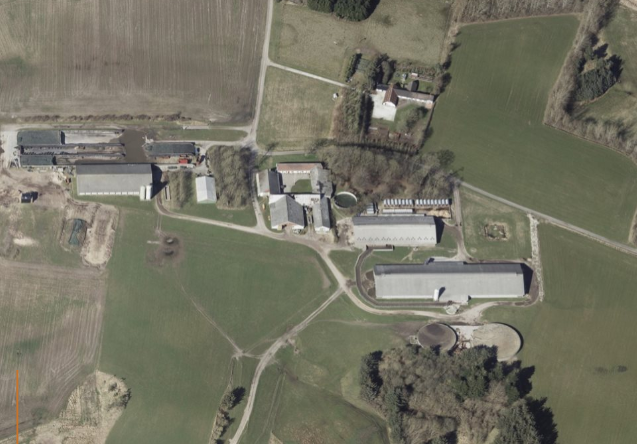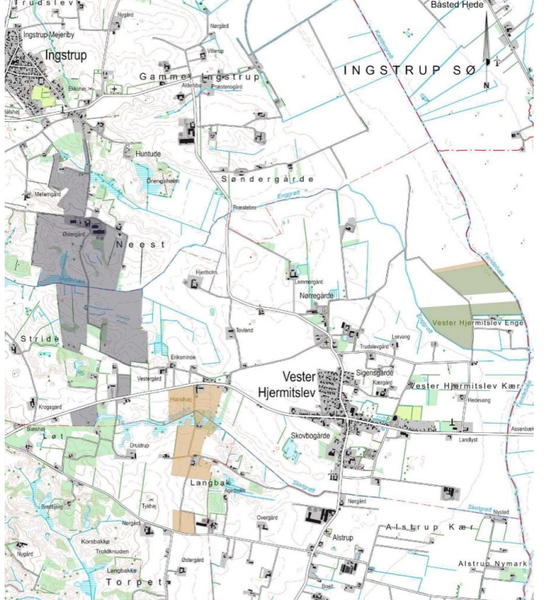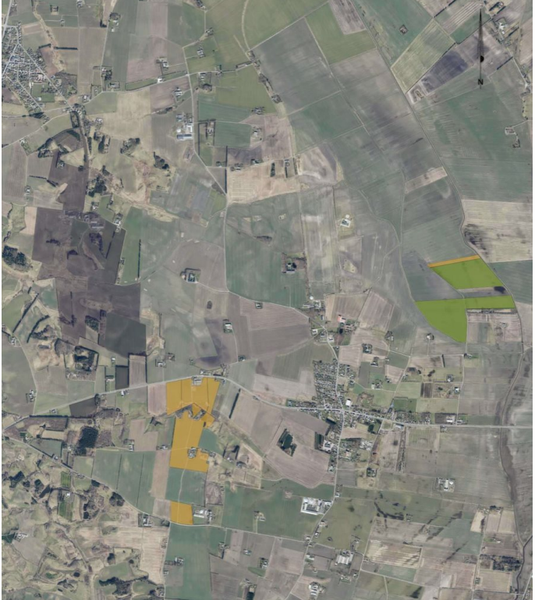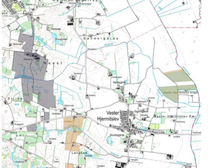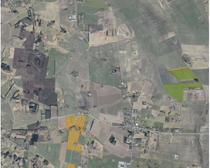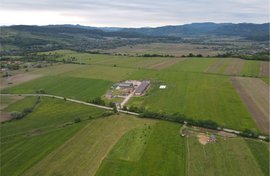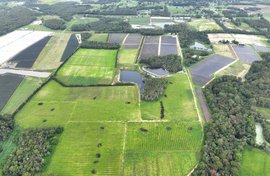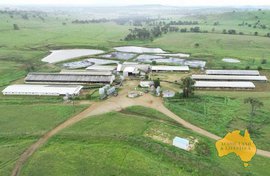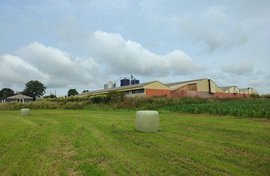Dairyfarm in Løkken
159.1 ha. DKK 34,500,000,- For sale Dairy
Løkken, Northern Jyland, Denmark
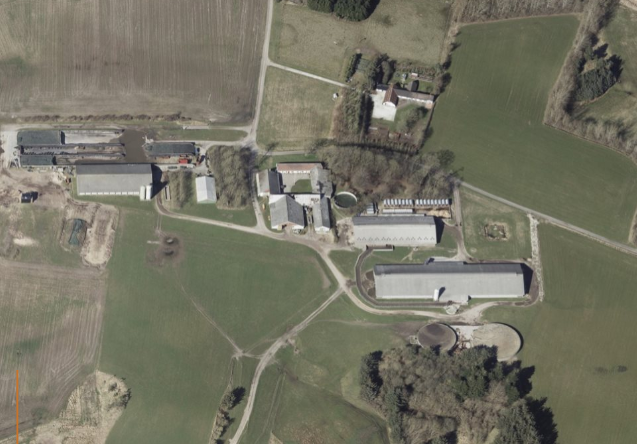
The estate ''Østergård’ is a well-run cattle farm with space for more than 400 cows. There were previously four robots on the property, but these have been removed. All heifers are outsourced to a farmer in Hobro and a farmer in Gl. Vittrup. Today, there is a milking parlour in the oldest dairy barn. The farm consists of 3 parts, the main building, one without a building and one where a fattening silo has been installed.
The land:
The total area of the properties is 159.1161 ha. Of this, 121.11 ha is arable land, 3.91 ha is pasture 14.22 ha. Section 3, the rest is arable land, etc. Some of the areas are very hilly. All properties are located near the main property. See area map in the presentation.
Engine house/garage and boiler room:
Building 5 was built in 1900/1980 and has an area of 300 m². There are steel trusses and part is used for machinery. There is also a double garage, workshop and boiler room with changing rooms for employees.
Barn:
Gl. barn building 3 was built in 1900 and has an area of 260 m². The barn is ready for demolition, used for small circulation.
Old barn:
Stables buildings 2 and 6 were built in 1950/1980 and have a total area of 651 m². There are 23 stalls, as well as slatted and deep litter stalls. Feed alley in the middle. At the end of the building there is a separate barn with straw storage.
Barn:
Barn Building 4 was built in 1974 and has an area of 500 m². It houses some small machines and machinery used in daily operations.
Detached barn:
Barn building 8 was built in 1995 and has an area of 1,414 m². It is furnished with 140 stalls with mattresses and slats behind them. There is partial self-closing feed fence. Straw pens of 100 m². In the barn there are 2 x 8 Delaval milking parlours side by side from 1998. In addition, there is a calf kitchen, technical room, office, toilet. At both ends there is a large gate. The cows from the other barn are driven up here and milked.
Asphalt room:
Outside the loose housing barn, there is a large area where there are 4 older pens used for calving pens, 39 raised single pens for calves and 17 communal pens for larger calves.
Detached barn:
The barn building 9 was built in 2011 and has an area of 2,820 m². It is a former robot barn with space for 4 robots. The barn is equipped with a tank room with a 2,000 l buffer tank. Outside is a 24,000 l silo tank. The barn is divided into 4 sections, each with 65 cubicles with water beds, there is a solid floor behind the cubicles where there used to be manure sliders. Large gate at both ends and wide feed alley. Cows from this barn are driven into the milking parlour via a ramp in the second loose drift. There is a requirement from the environmental authorities that manure sliders be reinstalled in the stables, alternatively a new environmental licence is required.
Former aircraft hangar:
Building 7 was built in 1975 and has an area of 240 m². It is currently used for small machinery. Is with gate at the end.
Feed shed:
Building 10 was built in 2011 and has a registered area of 1,300 sqm. It is used for several feed warehouses. Outside, there are 2 large glass fibre silos.
Silage silos:
There are 5 silos outside the feed shed. The 2 are 10 m. wide, 32 m. long and 2.8 m. high, in addition there are 2 that are 10 m. wide and 72 m. long and 2.8 m. high. The last one is 14 m. wide and 72 m. long and 2.8 m. high. There is asphalt between the sils and to the west there is a 15 m long space with asphalt after pit silos.
Water basin:
To the east of the feed shed is a basin for collecting surface water. This is led by a pipeline to 2 sprinklers.
Farmhouse:
Built in 1877, the house has a living area of 210 m². Nicely furnished and decorated as follows, hall, living room, room, corridor, bathroom, living room, kitchen, corridor, room, bathroom, 2 rooms, bedroom and back corridor
-
id2534
-
size159.1 ha.
-
typeDairy
-
countryDenmark
-
countyNorthern Jyland
-
cityLøkken
- show on map
Interfarms Denmark
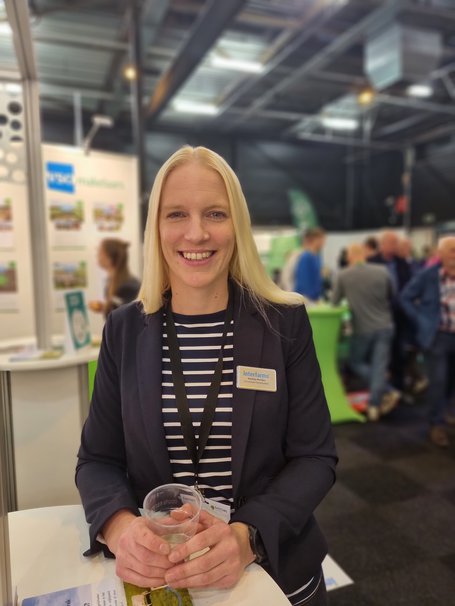
About Denmark
Denmark is one of the oldest kingdoms in the world. Denmark consists of the large peninsula of Jutland and some large islands. The island of Fyn is connected with Jutland via a bridge. The island of Zealand is connected with Fyn by means of a tunnel and a bridge. In addition, Greenland and the Faeroe Islands are part of the State of Denmark. The capital city of Copenhagen is situated on the island of Zealand. The only country border is the one with the German state of Schleswig-Holstein. Recently, a bridge has been built between Denmark and Sweden. Furthermore, Denmark is surrounded by the North Sea (on the west), the Kattegat between Jutland and Sweden, and the Sound between Zealand and Sweden. The capital city of Copenhagen is situated by the sea, the Sound, and it has a population of approximately one and a half million. As a port, Copenhagen is the trade centre for i.a. industries, breweries (Carlsberg, Tuborg) and shipbuilding (Maersk). Denmark has approximately 5.8 million inhabitants. This means that it has an average of 136 people per square kilometre. Over half the Danish population live on the islands east of Jutland, whereas a quarter of the population live in or around the capital city of Copenhagen. At present, over 80% of the population live in urban areas, and this number will further increase as a result of industrial growth.
Social security contributions are paid through the tax system. As a result, no tuition fees, no contributions for national compulsory health insurance, and no old-age pension contributions need to be paid. Children in Denmark have to attend compulsory education between the ages of 7 and 16. From the age of three, they may go to a børnehave (a kind of pre-school/kindergarten), from the age of six they can go to the preparatory year for primary school. Most villages have a school. Primary school is attended for nine years, after which there is an optional tenth year, which is often attended at the principal town of the municipality. Most children (93%) go to the folke schools, which are free. According to the present Constitution, the Evangelical-Lutheran Church is the Danish folkekirken (= people’s church), and as such it is supported by the State. Approx. 95% of all Danes are members of the folkekirken. Apart from members of folkekirken, there are about 6500 Roman Catholics, 700 Reformed Protestants and 6500 Baptists in Denmark. These churches are recognized by the Danish State.
Denmark has a maritime climate. Average annual precipitation is around 664 mm, half of which falls between July and October. The wettest month is August at 81 mm; the driest month is February with an average rainfall of 39 mm. In summer, occasional stormy winds from the west bring some cool weather. Winters are temperate due to a westerly gulf stream that tempers the cold. The Danish weather is changeable but never extreme. April and May are mild. In general, the months of June, July and August are warm (16.6 °C on average). A typical Danish summer has alternating periods of rain and sun. The spring months are pleasant, but cooler. The winter months are cool and sometimes cold, while light snowfall is normal. February is the coldest month of the year at an average temperature of -0.4°C.
Denmark produces food for approximately 15 million people (three times the Danish demand), two-thirds of which are exported. Despite the important part played by agriculture in Denmark, only 96,000 people, i.e. 3% of Demark’s total workforce, work in agriculture. Denmark has about 42,000 farming operations; as recently as 1950 this figure stood at 200,000. During the last decade, the average size of farming operations has increased from 21 to 65 ha. The average age of the Danish farmer is 52. Dairy farming Denmark is a dairy country that exports many dairy products. The national milk quota is 4.6 billion kg . A large share of its exports goes to the EU (Germany 20%, Great Britain 15%). All dairy farmers can buy quotas at the quota exchange. There are four trading-rounds at the exchange each year. The price is set on the basis of the average of amounts of supply and demand. From all transactions, 1% is skimmed off for the benefit of start-up farmers. All transactions conducted outside the exchange system get deducted by 50%. To prevent overproduction of manure in concentration areas, Danish agriculture has a system whereby there has to be a balance between the number of animals at a farm and the number of hectares. In this regard, a distinction is made between the different kinds of animals, the quantity of animals, and the number of hectares owned. Of the requisite amount of land, 30% must be freehold. The surplus amount of manure can be disposed of through leases or manure disposal arrangements. All livestock farmers must submit a cropping plan to the plantdirektorat. This includes a specification of crops for each parcel of land and the fertilization plan involved. The farmers’ association then calculates the permitted amount of artificial fertilizers to be spread, taking into account a useful nitrogen content of 45% from liquid manure. In the months of October through January, there is a ban on the disposal and application of manure. The storage capacity of manure for existing farms extends over a period of 7 months, and, for new farms, 9 months. In Denmark, farms are traditionally built on the attached land-parcels so that most of the “original” lands lie around the buildings. Historically, Danes are arable farmers who began keeping livestock to eat their crops and use their straw. There is still a lot of arable farming in Denmark, so you can see a great many cereal crops there. Maize is grown in Denmark. Soil types vary from light sandy soil to clay soil. The lighter sandy soils generally have to be irrigated in the period of July/August, because these months are often hot and dry.
